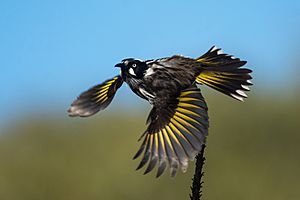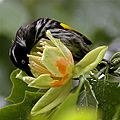New Holland honeyeater facts for kids
Quick facts for kids New Holland honeyeater |
|
|---|---|
 |
|
| New Holland honeyeater in Victoria, Australia | |
| Conservation status | |
| Scientific classification |
The New Holland honeyeater (Phylidonyris novaehollandiae) is a busy bird found in southern Australia. It's a type of honeyeater, known for drinking nectar from flowers. This bird was one of the first Australian birds to be studied by scientists.
Contents
About the New Holland Honeyeater
Scientists group living things into different categories. This helps us understand how they are related. The New Holland honeyeater has a scientific name, Phylidonyris novaehollandiae. There are five slightly different types, called subspecies, found in various parts of Australia:
- The main type lives in south-eastern mainland Australia.
- Another type lives in Tasmania.
- One type is found on Kangaroo Island, South Australia.
- A type lives in Western Australia.
- The last type lives on the islands in Bass Strait.
What Does a New Holland Honeyeater Look Like?
This bird is about 18 centimeters (7 inches) long. It is mostly black with bright white eyes. It also has white fluffy feathers on its face. Its wing and tail feathers have yellow edges, which makes them stand out.
New Holland honeyeaters are very active birds. They rarely stay still for long! If a bird of prey or other danger comes near, a group of honeyeaters will gather. They will then make a special warning call to alert others.
Male and female New Holland honeyeaters look quite similar. However, females are usually a little smaller. Young honeyeaters (under one year old) have similar colors. But they have grey eyes and a yellow area around their beak.
How Do New Holland Honeyeaters Reproduce?
New Holland honeyeaters build nests and raise their young. In southern and eastern Australia, they often breed in autumn and spring. Some groups living near the coast might breed at any time of year. This happens if there is enough food and good weather. In Western Australia, they usually breed once a year, from July to November. This is when there is lots of nectar available.
During breeding season, male honeyeaters spend a lot of time protecting their nest and food sources. Females do most of the work building the nest. They also sit on the eggs to keep them warm and care for the baby birds. Females often find food close to the nest. Males, however, might fly further away to find food.
What Do New Holland Honeyeaters Eat?
New Holland honeyeaters get most of their energy from the sweet liquid called nectar. Nectar is found inside flowers. Because they visit so many flowers, they help pollinate many plants. This means they help the plants make seeds. Many of these plants, like Banksia and Hakea, are only found in Australia.
Even though they love nectar, honeyeaters also need protein. Nectar does not have protein. So, they also eat small creatures like spiders and insects. These provide the protein they need to stay healthy. They sometimes feed alone, but often gather in groups.
Gallery
See also
 In Spanish: Mielero de Nueva Holanda para niños
In Spanish: Mielero de Nueva Holanda para niños





